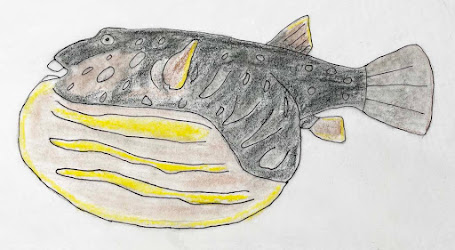There are about 120 species (some very colorful) of this fish (also known as puffers, blowfish, balloonfish, fugu, swellfish, and globefish) that can inflate up many times its normal size in order not to swallowed whole by a predator. Puffer fish fill their elastic stomachs repeatedly with huge amounts of water, until they enlarge their body size several times their normal size (which can be as much as up to 3 times). They can exhale this water rapidly, if necessary. Pufferfish have no scales; instead, they have spines. Some pufferfish have long spines to also help ward off predators. Thus these pufferfish look like porcupines.
inches wide; from Mexico? Image courtesy of L.T. Groves, Collections Manager of Malacology, Natural History Museum of Los Angeles County, California.
Pufferfish are generally believed to the second-most poisonous vertebrate, after the golden poison frog. The poison of pufferfish is tetrodotoxin, a powerful neurotoxin. There is enough poison in a single pufferfish to kill 30 adult humans, and there is no antidote! Death can occur within three minutes. Interestingly, sharks are immune to pufferfish poison.
Puffer fish is prepared and served as a very expensive delicacy in the Far East. But, if this fish is improperly prepared for human consumption it can cause death (within 24 hours) because nearly all puffer fish species are highly poisonous. In Japan, a special “Chef’s License” is needed to prepare this delicacy, called “fugu.” These chefs know which parts, and how much of them, are safe to eat (Wikipedia).
Pufferfish live in warm waters and are found throughout the tropical (including coral reefs) to subtropical marine waters of the world. A few, however, can live in brackish or even fresh water. The smallest pufferfish are about 8 cm long, and the largest individuals are up to 1 m long. Pufferfish are known for building intricate circular nests, up to 2 m in diameter, in sand.
Some people keep pufferfish as pets. If other fish are in the same aquarium, they have to be alert and quick swimmers to avoid being eaten by the pufferfish, which can have enormous appetites (they especially like to also eat earthworms fed to them).
These fish are named for their four large teeth: two chisel-like teeth in the top of the mouth and two fused into a flattened, broad plate. These teeth are used just like beaks for crushing their natural prey: crustaceans and mollusks. Eating even the shelly parts of their prey keep the puffer fish teeth sharp. Puffer fish have a geologic range from the Eocene to modern day.
Tetraodon lineatus Linnaeus, 1758. From Wikipedia. This species is named for its four teeth (two large chisel-like teeth on upper jaw and two very wide flat teeth on the lower jaw. This can be an aggressive and intolerant fish that should be avoided because its teeth are sharp and its jaws are strong. The teeth grow each day and need to be worn down. This sketch is “based” on an image in Wikipedia.
References Consulted:
keywestaquarium.com
Wikipedia.org
Note: If you a fan of television’s “Homer Simpson” show, you might want to watch--on YouTube for free, Simpson’s Season 2, Episode 11, entitled “One Fish, Two Fish, Blowfish, Blue Fish,” where he eats a whole, a poisonous fugu fish and is told he has less than 24 hours to live. He decides to see what happens, but then he is arrested for drunk driving, etc.



No comments:
Post a Comment